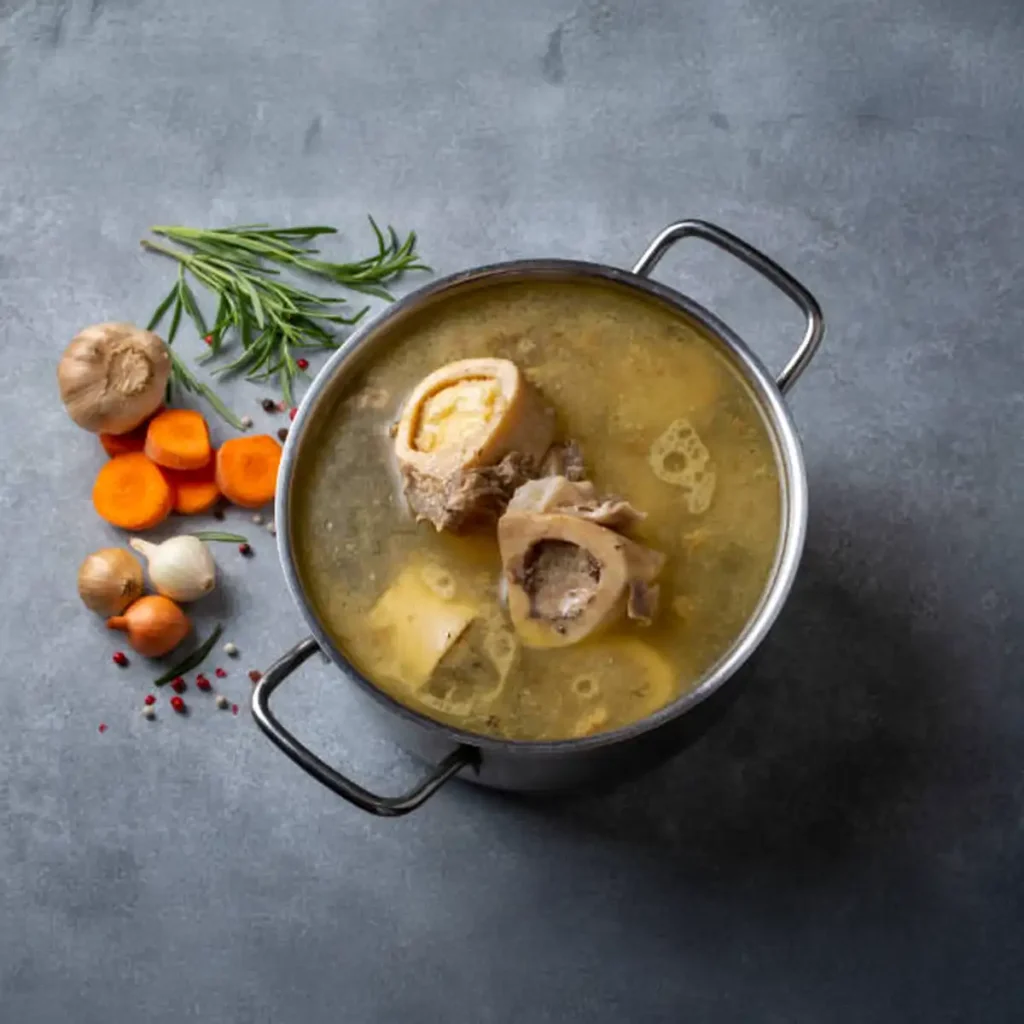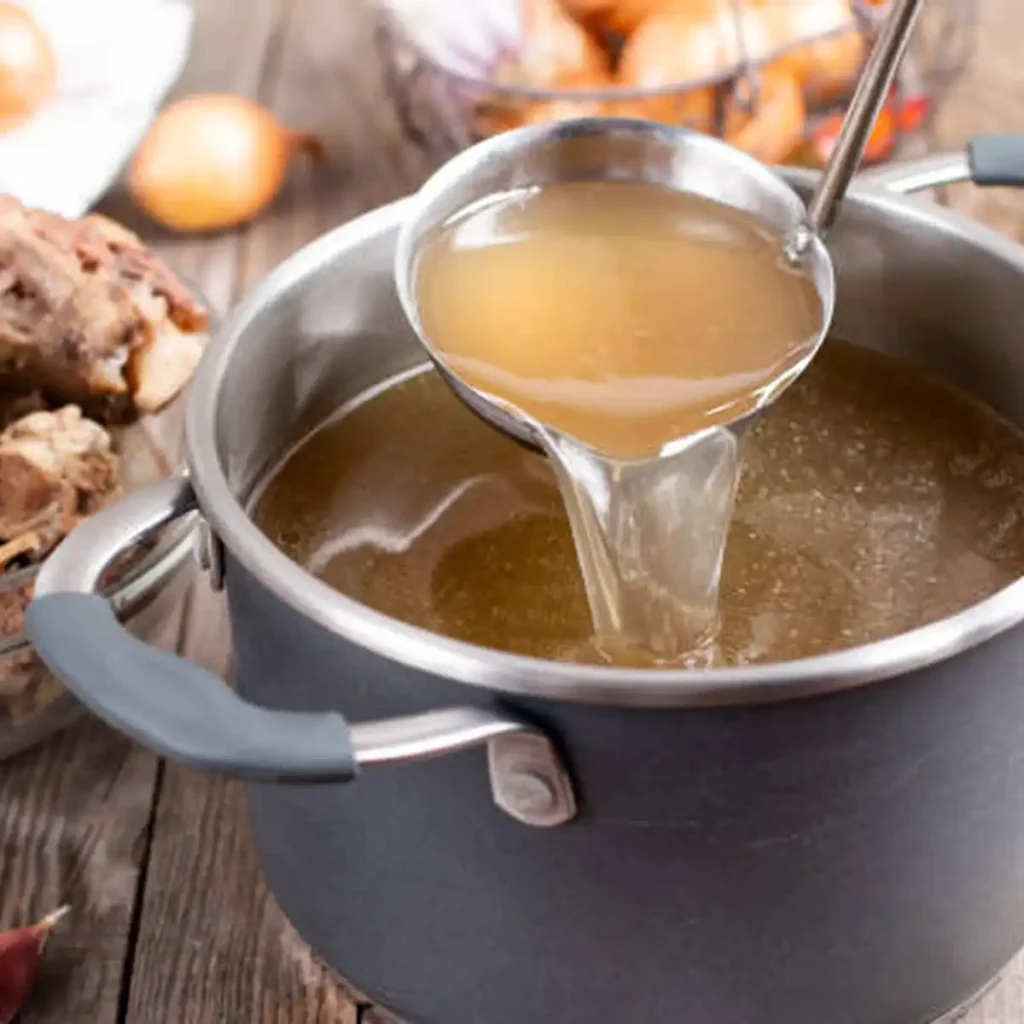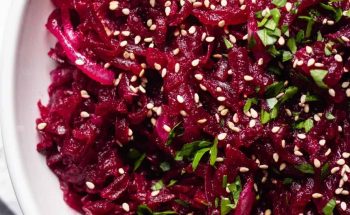A well-made cup of beef bone broth is warming, savoury and deeply satisfying, yet its health reputation is often exaggerated or misunderstood. For most people it is best viewed as a functional food that can support gut health, hydration and satiety in winter, not as a miracle cure for bones or joints. Used with realistic expectations and a careful eye on quality and safety, it can play a helpful part in a broader healthy eating pattern across the colder months.
This analysis unpacks what bone broth actually is, what is in a typical serving, which benefits are supported by evidence, where claims go beyond the data, and who should avoid or limit it. It also offers a practical beef marrow and rib broth recipe tailored to winter wellness, so readers can move from marketing claims to informed choices in their own kitchens.
Understanding What Bone Broth Really Is
Bone broth is best understood as a long-simmered stock made for drinking rather than merely as a cooking ingredient. Classic broth is a lightly flavoured liquid made by simmering meat with vegetables for under 2 hours, usually seasoned and ready to eat as a simple soup. Stock is traditionally made from bones and connective tissue simmered for 4 to 6 hours to extract collagen, producing a wobbly, gel-like liquid once chilled that is used as a base for sauces and soups.
What many brands and wellness influencers now call bone broth is an extended stock. Bones and connective tissue are simmered for 12 to 24 hours or more, often with a splash of vinegar to acidify the pot. The intention is to extract more collagen, gelatin, amino acids and minerals than in a standard stock and then to sell or consume the result as a standalone health drink. In practice, the difference is less about strict culinary technique and more about purpose and marketing.
How Marrow Ribs And Knuckles Shape Your Broth
A balanced bone broth depends on the mix of bones rather than a single cut. Marrow bones from the femur or shank bring richness and fat, creating a fuller mouthfeel and deeper savoury flavour. Knuckle, joint, and foot bones supply cartilage and connective tissue that are rich in collagen, which breaks down into gelatin and gives cooled broth its characteristic jelly-like wobble.
Meaty bones such as short ribs, neck bones or oxtail contribute both flavour and protein. When roasted before simmering, they develop browned, complex notes through the Maillard reaction, which is essential for a robust beef bone broth recipe that can stand alone in a mug or form the base of a satisfying winter soup. Using all three types together delivers fat for flavour, joint bones for gelatin and meaty bones for depth.
Why Broth Sits At The Heart Of Winter Cuisines
Across cultures, slow-cooked broths have long been used as practical winter food rather than fashionable wellness products. Anthropological evidence suggests that early humans simmered bones in water as soon as they had vessels that could withstand heat, extracting nutrition from parts of the animal that could not easily be eaten directly.
In many traditional cuisines, from French stocks to East Asian soups, broths are everyday building blocks. In colder months, a hot bowl of soup or broth offers warmth, hydration, and easily digested nourishment, particularly during illness when appetite is low. Traditional medical systems have often framed these preparations as strengthening foods for the sick or depleted, an idea that has resurfaced in modern marketing around bone broth and winter wellness.
Fun fact: The classic phrase “a chicken soup for a cold” has roots in historical medical texts, where broths were recommended to support the weak long before anyone knew about immune cells or amino acids.
What Is Actually In A Cup Of Beef Bone Broth
From a nutritional perspective, a typical cup of beef bone broth is modest in energy but concentrated in certain nutrients. Broadly, a 250 ml serving usually contains between 35 and 85 kcal, almost no carbohydrates, a small to moderate amount of fat depending on skimming, and roughly 4.5 to 10 g of protein, most of it in the form of collagen-derived gelatin.
The mineral picture is more surprising. Despite the association with bones, the calcium and magnesium content are generally low. Analyses of commercial and homemade broths show that calcium is often well under 2 % of daily intake per cup, with magnesium also relatively modest. In contrast, phosphorus and potassium can be much higher, with phosphorus sometimes reaching around 40 % of daily needs in a single serving, alongside meaningful amounts of potassium and notable zinc.
A simplified snapshot looks like this:
| Nutrient | Typical Amount (per 250 ml) | Approximate % of Daily Intake | Notes |
| Calories | 35–85 kcal | 2–4 % | Very low energy |
| Protein | 4.5–10 g | 9–20 % | Mainly collagen derived gelatin |
| Fat | 0.5–3 g | <5 % if skimmed | Higher if marrow and fat are retained |
| Carbohydrates | 0 g | 0 % | No meaningful carbs |
| Sodium | 100–600 mg or more | 4–25 % or higher | Varies widely, especially in packaged broths |
| Potassium | ~270 mg | ~8 % | Useful electrolyte |
| Phosphorus | ~300 mg | ~43 % | High relative to daily requirement |
| Calcium | 7–13 mg | <1–2 % | Negligible contribution to bone health |
| Magnesium | ~2.6–20 mg | <1–5 % | Relatively low |
| Zinc | ~5 mg | ~45 % | Supports immune function |
These numbers vary with ingredients and technique, but they make one message clear. Bone broth is a valuable source of specific amino acids and certain minerals, yet it is not a concentrated source of calcium or magnesium.
How Protein Gelatin And Fat Work In Bone Broth
For most people the main nutritional value of bone broth comes from its protein and gelatin content rather than its micronutrients. The protein in broth is largely collagen-based and therefore incomplete, meaning it is low in some essential amino acids, such as tryptophan. It does, however, provide a dense supply of non-essential and conditionally essential amino acids that have distinct physiological roles.
During long, slow cooking, collagen unwinds and hydrolyses into gelatin. This gelatin gives chilled broth its characteristic wobble, thickens soups and sauces and is believed to play a role in supporting the gut lining and connective tissues. Gelatin-rich liquids also tend to be satiating. Many people find that a mug of bone broth supports appetite control, especially when taken between meals during weight-loss efforts.
Fat content is highly variable. Marrow bones contribute rich tallow that sets into a solid cap when chilled. Skimming this fat produces a lighter, lower-calorie drink, while leaving some or all of it in place increases energy density and gives a more luxurious texture. The choice depends on individual energy needs and preferences.
Why Bone Broth Is Not A Mineral Supplement
The popular belief that long-simmered bones release large quantities of calcium and magnesium into broth does not hold up under detailed analysis. Laboratory studies of both homemade and commercial products consistently show that, while these minerals are detectable, they remain too low to make a meaningful contribution to daily intake for bone health. Broth is therefore not a substitute for calcium-rich foods such as dairy products or fortified plant milks, nor for magnesium-rich foods such as whole grains, nuts and leafy greens.
The more striking finding is the relatively high phosphorus and potassium content. For most healthy people, this is not a concern and may be helpful as part of everyday electrolyte intake. For people living with chronic kidney disease, however, concentrated phosphorus and potassium can be problematic because their kidneys have difficulty clearing these minerals. In that context, regular or large servings of beef bone broth may be unhelpful or even harmful, and medical guidance is advisable.
How Amino Acids Drive Bone Broth Benefits
The most credible benefits of bone broth are linked to its distinctive amino acid profile. Long-simmered beef bones and connective tissue release high levels of glycine, proline and its derivative hydroxyproline, glutamine and arginine. These are key building blocks for collagen and for tissues that turn over quickly, such as the gut lining.
Glutamine is the primary fuel for the cells lining the small intestine and plays a central role in maintaining gut barrier integrity. Experimental studies suggest it can influence intestinal permeability, often described in lay terms as “leaky gut”. Glycine has anti-inflammatory and calming properties in some contexts and is involved in the synthesis of glutathione, an important antioxidant. Proline and hydroxyproline are essential for forming strong collagen fibres, while arginine contributes to blood flow and immune function.
While the exact dosing and long-term effects of these amino acids from broth are still being explored, their known roles make it plausible that regular intake of gelatin-rich broth can support gut integrity and, indirectly, aspects of immunity and recovery.
How Time Acidity And Pressure Change Nutrient Extraction
The composition of homemade bone broth is highly sensitive to how it is prepared. Longer simmering increases extraction of proteins, fats and amino acids. Studies on both beef and chicken broths suggest that nutrients continue to migrate into the cooking liquid for many hours, with collagen and amino acids rising steadily over time. Traditional simmering periods of 12 to 24 hours are therefore well aligned with the goal of maximising gelatin and amino acid content.
Acidity also matters. Adding a small amount of vinegar or wine to cold water before heating reduces the pH and has been shown to increase the extraction of minerals such as calcium and magnesium by large relative percentages. However, because the starting values are low, even a dramatic relative increase still results in modest absolute amounts. In practice, acidifying the pot makes sense for efficient extraction, but it does not transform broth into a mineral supplement.
Pressure cookers offer a modern alternative to all-night simmering. They can produce gelled, collagen-rich broth in 3 to 4 hours. The higher temperature does not destroy minerals or amino acids, although very prolonged pressure cooking can break down gelatin to the point where the cooled liquid no longer sets, even if the amino acids remain present. Slow cookers provide a safe, hands-off way to extract nutrients over 24 to 48 hours, though initial scum removal is less convenient.
Winter Wellness Benefits You Can Expect From Bone Broth
Bone broth offers several practical benefits in cold weather that are well supported by evidence and everyday experience. It is mostly water, so it helps maintain hydration at times when people may drink less plain water. The combination of fluid, electrolytes and warmth makes it particularly useful during minor winter illnesses.
Its protein and gelatin content contribute to feelings of fullness despite the low calorie count. For those managing their weight, a mug of broth before or between meals can help reduce hunger and overall energy intake, especially when compared with sugary hot drinks. Finally, the simple comfort of holding and sipping a steaming mug should not be underestimated. The psychological and sensory aspects of warm liquids have long been valued in convalescence and seasonal self-care.
How Bone Broth Influences Immune Function
Claims that bone broth “boosts” the immune system are often overstated, but there are plausible indirect pathways. A large proportion of immune activity is concentrated in the gut, and anything that supports gut barrier integrity may help maintain balanced immune responses. The anti-inflammatory potential of amino acids such as glycine, alongside adequate hydration, could also play a subtle role in how the body handles infection.
Clinical work on enriched chicken broths has found measurable reductions in inflammatory markers in laboratory settings. These findings suggest that carefully formulated broths can influence immune-related pathways. However, such products are not the same as a homemade beef broth simmered on the hob, and there is currently limited direct human trial evidence connecting everyday bone broth intake with lower infection rates or shorter colds.
Bone Broth And Gut Integrity Evidence So Far
Gut health is where bone broth has the strongest scientific support. Recent clinical reviews, including work from major teaching hospitals, have examined the evidence on its key components and concluded that they can meaningfully support the intestinal barrier. These reviews point towards glutamine, glycine, proline, arginine and minerals such as zinc as the main contributors.
Taken together, the data suggest that gelatin-rich liquids can help maintain mucosal integrity, reduce inflammation in the gut lining and may enhance nutrient absorption in certain contexts. These conclusions are still described as emerging rather than definitive, yet they lend scientific weight to the long-standing tradition of using broths as “healing” foods during digestive upsets or recovery. For many health-conscious adults, this is the most compelling reason to integrate bone broth into a winter wellness blog-style routine.


Joint Health Claims What We Know
Joint health is one of the most heavily marketed benefits of bone broth, largely by association with collagen supplements. Randomised controlled trials show that daily doses of hydrolysed collagen, typically around 10 to 20 g, can reduce joint pain in athletes and improve symptoms in osteoarthritis. This is strong evidence that collagen peptides can be helpful at therapeutic doses.
The leap from these supplements to a mug of bone broth, however, is not straightforward. Analyses of different bone broths show that levels of collagen-related amino acids are highly variable and often substantially lower than the quantities used in supplement trials. Cafe-prepared broths sometimes score higher than typical home batches, but even then, there is no guarantee of a consistent dose.
It is therefore more accurate to say that bone broth contains some of the same building blocks used in joint health supplements, but not at reliably therapeutic levels. For people with joint concerns, broth can be a supportive food, yet it should not replace established treatments or targeted supplementation discussed with a healthcare professional.
Comfort, Hydration And Satiety In Cold Weather
In practical terms, the most immediate benefits of bone broth are comfort, hydration and satiety. On cold days, many people instinctively reach for hot drinks. Replacing a sugary hot chocolate or syrup-laden coffee with a savoury mug of broth cuts sugar while still providing warmth and satisfaction.
The water and electrolytes support everyday hydration, which is important for energy levels, digestion and concentration. The protein and gelatin slow gastric emptying and encourage fullness, so incorporating bone broth into a detox diet, style reset or a structured weight management plan can help people feel less deprived while keeping total calories in check.
Risks, Cautions And Who Should Avoid Bone Broth
For most healthy adults, moderate bone broth consumption is safe. There are, however, groups that need to be cautious.
Concerns about heavy metals such as lead and cadmium have been investigated. Modern analyses show that, although small amounts of these metals can be detected in long simmered broths, the levels are low and usually within safe limits for typical consumption. The more important factor is the quality of the animals and environment from which the bones are sourced.
Histamine is another commonly misunderstood issue. Histamine forms when bacteria break down the amino acid histidine in foods that are not stored correctly. Long cooking at a steady simmer does not create histamine, because the heat kills bacteria. The real risk arises if bones and meat are left at room temperature for extended periods before cooking or if finished broth is cooled too slowly and stored improperly. People with histamine sensitivity should focus on freshness and good food hygiene rather than avoiding long simmer times.
Two conditions warrant particular care. People with gout are sensitive to purines, which metabolise into uric acid. Beef, organ meats and rich stocks can raise uric acid levels and may trigger attacks, so those with gout are usually advised to limit such foods. People with moderate to advanced chronic kidney disease often need to restrict phosphorus and potassium, both of which are relatively concentrated in bone broth. In these cases, medical or dietetic guidance is essential.
Hypertension is a further consideration. Homemade broths can be made with little or no added salt, but many commercial bone broths are heavily salted to improve flavour. Anyone monitoring blood pressure should read labels carefully and, where possible, prepare their own low-sodium versions. A small number of people also report sensitivity to glutamate rich foods. While the evidence for widespread adverse reactions is limited, those who notice consistent symptoms may choose to limit intake.
Sourcing And Kitchen Technique For Safer Broth
Quality starts with the animal. Grain finished cattle tend to produce fat with a higher proportion of omega-6 fats relative to omega-3, while grass-fed and grass-finished animals produce a more favourable fatty acid profile with more omega-3, conjugated linoleic acid and antioxidant vitamins. Even if much of the fat is skimmed from the broth, grass-fed tallow is a more nutritious cooking fat, and many readers value the animal welfare and environmental benefits of pasture-based systems.
Organic certification, while not a guarantee of superior nutrient levels, does offer reassurance that animals have not been given growth hormones and that their feed meets strict standards. Given that bone broth involves concentrating compounds from bones and tissues over long cooking periods, starting with high quality, preferably organic bones is a reasonable precaution for anyone concerned about residues.
In the kitchen, technique influences both flavour and safety. Roasting bones and vegetables at around 220 °C before simmering creates a dark, richly flavoured broth. Blanching bones briefly in boiling water before roasting or simmering removes some impurities and produces a cleaner-tasting, paler stock, a method common in several Asian traditions.
During simmering, grey foam rises to the surface in the first hour. Skimming this “scum” improves clarity but is not essential for safety. Fat is better skimmed after chilling, when it forms a firm cap that can be lifted off and either discarded or saved for cooking. The pot should be kept at a gentle simmer rather than a rolling boil to avoid emulsifying fat into the liquid and making it cloudy.
Food safety hinges on cooling and storage. Large quantities of hot broth should never be left on the hob or counter overnight. Instead, they should be strained into a metal container and cooled quickly in an ice bath, then transferred to the fridge once lukewarm. In the refrigerator, well-made broth typically keeps for 3 to 5 days. For longer storage, it freezes well, either in larger containers for soup bases or in smaller blocks for adding to sauces and stews. Reheat the broth to a full boil before serving.
For those who enjoy restaurant clear consommé, an egg white raft can be used to clarify cooled broth. Whisked egg whites, minced lean meat and vegetables are stirred into cold broth and then heated slowly. As the egg whites coagulate, they rise and trap fine particles, leaving a clear, refined liquid beneath once the raft is removed.
How Bone Broth Compares With Other Winter Soups
To understand where bone broth fits into a winter eating pattern, it helps to compare it with other soups. Conventional beef stock made from bones simmered for 3 to 4 hours contains less gelatin and fewer collagen-derived amino acids than a deliberately long-cooked bone broth, though it is still useful for cooking. A simple meat-based broth made mainly from muscle meat has more complete protein but very little gelatin.
Chicken bone broth, particularly when made with joints and feet, is rich in type II collagen, which is prominent in cartilage. Beef bone broth is higher in type I and III collagen, which predominate in skin, bone and the lining of blood vessels and the gut. Chicken broths can be a strong choice for those focused on joint support, while beef broths may be better suited to those particularly interested in gut health and skin.
Vegetable soups and broths occupy a different nutritional niche. Clear vegetable broths and vegetable-based soups are excellent sources of vitamins, minerals, phytonutrients, and, when legumes are involved, fibre and plant protein. They do not contain collagen or gelatin and have very different amino acid profiles. In practice, the best winter pattern for healthy eating combines both: collagen-rich broths for amino acids and comfort, and plant-based soups for fibre and micronutrients.
What Nutrition Experts Really Think About Bone Broth
Registered dietitians and mainstream nutrition bodies tend to see bone broth as a useful food rather than a medical treatment. Many dietitians regard it as a pleasant, protein-rich drink that can fit comfortably into a balanced diet, while cautioning against inflated claims. They emphasise that its benefits do not replace the fundamentals of a varied, plant-rich eating pattern.
Practitioners working in functional and integrative medicine are more enthusiastic. They often place bone broth near the foundation of protocols for supporting gut integrity, drawing on the known roles of glutamine, glycine and gelatin in barrier function and repair. They also highlight connections between gut health, bone health and immunity, proposing that regular intake of broth contributes indirectly to a wide range of outcomes.
Recently, clinical reviews from respected institutions have started to bridge the gap between sceptical and enthusiastic camps. These analyses acknowledge that, while hard-outcome trials remain limited, the mechanistic evidence and early human data are sufficient to describe bone broth as a legitimate functional food for gut support. At the same time, large national organisations such as the NHS and leading dietetic associations have not issued formal position statements on bone broth, which indicates that it is still viewed primarily as food rather than as a recognised clinical intervention.
Practical Beef Marrow And Rib Broth Recipe For Winter
A practical way to translate this evidence into everyday life is to prepare a concentrated beef marrow and rib broth and then use it as the base for a hearty winter soup. The following method is designed to maximise flavour, gelatin and safety.
For the broth base, combine roughly equal weights of beef marrow bones, meaty short ribs or neck bones, and knuckle or joint bones, aiming for about 1.5 kg of each. Roast the bones with onions, carrots, celery and halved garlic at 220 °C until deeply browned. Transfer everything to a large stockpot, cover with cold filtered water, add 3 to 4 tablespoons of apple cider vinegar and leave to stand for half an hour.
Bring the pot to the boil, then immediately reduce to the lowest simmer and skim off any foam in the first hour. Add bay leaves, peppercorns and thyme, then simmer gently for 12 to 24 hours, topping up with water if needed. Once finished, remove the larger bones and vegetables, strain through a fine sieve, and cool rapidly in an ice bath, then refrigerate. The next day, lift off the solid fat cap and reserve it if you wish to cook with grass fed tallow. The liquid underneath should be firm and jelly-like when cold.
To turn this into a complete winter meal, soften diced onion, carrots, parsnips and turnip in a spoonful of tallow or olive oil, then add 2 litres of the broth base and any shredded meat from the short ribs. Stir in pearl barley and simmer until the grains are tender and the vegetables are cooked through. Season to taste and finish with chopped parsley. This delivers a warming, protein-rich, fibre-containing soup that aligns well with evidence-based diet-focused approaches to winter nutrition.
Where Bone Broth Fits In A Modern Healthy Diet
An evidence-based view of beef marrow and rib broth shows that it is neither a miracle cure nor an empty fad. It is a low-calorie, protein-rich drink that offers specific amino acids with credible benefits for gut integrity, some support for hydration and satiety, and a valuable sense of warmth and comfort during cold months. Its mineral profile does not justify claims of building strong bones, but its high phosphorus and potassium content, and the presence of purines, make it unsuitable for certain medical conditions such as gout and chronic kidney disease.
For health-conscious adults, the most realistic way to use bone broth is as a supportive part of a broader wellness-focused lifestyle. It can replace sugary hot drinks, form the foundation of nourishing soups, and contribute to gut-friendly eating patterns that include plenty of vegetables, whole grains and high-quality proteins. Sourced from grass-fed, preferably organic animals and prepared with sound kitchen technique, it is a sensible winter staple rather than a cure-all.
In the spirit of the old saying that “little and often fills the purse”, a modest, regular mug of well-made beef bone broth can quietly support comfort and digestion without overshadowing the simple fundamentals of a balanced, varied diet.





